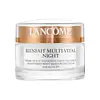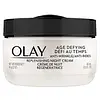What's inside
What's inside
 Key Ingredients
Key Ingredients

 Benefits
Benefits

 Concerns
Concerns

 Ingredients Side-by-side
Ingredients Side-by-side

Water
Skin ConditioningDimethicone
EmollientHydrogenated Polyisobutene
EmollientParaffinum Liquidum
EmollientGlycerin
HumectantCetyl Alcohol
EmollientButylene Glycol
HumectantPEG-100 Stearate
Glyceryl Stearate
EmollientOryza Sativa Bran Oil
EmollientZea Mays Oil
EmulsifyingHydroxyethylpiperazine Ethane Sulfonic Acid
BufferingCI 15985
Cosmetic ColorantCI 19140
Cosmetic ColorantC13-14 Isoparaffin
EmollientTocopheryl Acetate
AntioxidantTocopherol
AntioxidantAscorbyl Glucoside
AntioxidantHydroxycitronellal
PerfumingPhenoxyethanol
PreservativeMagnesium Aspartate
Skin ConditioningTriticum Vulgare Germ Oil
EmollientPolyacrylamide
Chlorhexidine Digluconate
AntimicrobialPolycaprolactone
StabilisingPanthenol
Skin ConditioningPentaerythrityl Tetra-Di-T-Butyl Hydroxyhydrocinnamate
AntioxidantBenzyl Salicylate
PerfumingBenzyl Alcohol
PerfumingLinalool
PerfumingZinc Gluconate
Skin ConditioningCaprylyl Glycol
EmollientAlpha-Isomethyl Ionone
PerfumingCopper Gluconate
Skin ConditioningSorbitan Tristearate
EmulsifyingCera Microcristallina
Emulsion StabilisingParaffin
PerfumingSesamum Indicum Seed Oil
EmollientRetinyl Palmitate
Skin ConditioningButylphenyl Methylpropional
PerfumingLaureth-7
EmulsifyingHexyl Cinnamal
PerfumingGlycine Soja Oil
EmollientParfum
MaskingWater, Dimethicone, Hydrogenated Polyisobutene, Paraffinum Liquidum, Glycerin, Cetyl Alcohol, Butylene Glycol, PEG-100 Stearate, Glyceryl Stearate, Oryza Sativa Bran Oil, Zea Mays Oil, Hydroxyethylpiperazine Ethane Sulfonic Acid, CI 15985, CI 19140, C13-14 Isoparaffin, Tocopheryl Acetate, Tocopherol, Ascorbyl Glucoside, Hydroxycitronellal, Phenoxyethanol, Magnesium Aspartate, Triticum Vulgare Germ Oil, Polyacrylamide, Chlorhexidine Digluconate, Polycaprolactone, Panthenol, Pentaerythrityl Tetra-Di-T-Butyl Hydroxyhydrocinnamate, Benzyl Salicylate, Benzyl Alcohol, Linalool, Zinc Gluconate, Caprylyl Glycol, Alpha-Isomethyl Ionone, Copper Gluconate, Sorbitan Tristearate, Cera Microcristallina, Paraffin, Sesamum Indicum Seed Oil, Retinyl Palmitate, Butylphenyl Methylpropional, Laureth-7, Hexyl Cinnamal, Glycine Soja Oil, Parfum
Water
Skin ConditioningGlycerin
HumectantIsohexadecane
EmollientNiacinamide
SmoothingDimethicone
EmollientIsopropyl Isostearate
EmollientPolyacrylamide
Titanium Dioxide
Cosmetic ColorantPanthenol
Skin ConditioningTocopheryl Acetate
AntioxidantRetinyl Propionate
Skin ConditioningEthylhexyl Salicylate
UV AbsorberAscorbic Acid
AntioxidantStearyl Alcohol
EmollientC13-14 Isoparaffin
EmollientLaureth-7
EmulsifyingDimethiconol
EmollientAmmonium Polyacrylate
StabilisingCetyl Alcohol
EmollientPolyethylene
AbrasiveAluminum Starch Octenylsuccinate
AbsorbentBehenyl Alcohol
EmollientBenzyl Alcohol
PerfumingCetearyl Glucoside
EmulsifyingCetearyl Alcohol
EmollientEthylparaben
PreservativeStearic Acid
CleansingPEG-100 Stearate
Propylparaben
PreservativeDisodium EDTA
Parfum
MaskingWater, Glycerin, Isohexadecane, Niacinamide, Dimethicone, Isopropyl Isostearate, Polyacrylamide, Titanium Dioxide, Panthenol, Tocopheryl Acetate, Retinyl Propionate, Ethylhexyl Salicylate, Ascorbic Acid, Stearyl Alcohol, C13-14 Isoparaffin, Laureth-7, Dimethiconol, Ammonium Polyacrylate, Cetyl Alcohol, Polyethylene, Aluminum Starch Octenylsuccinate, Behenyl Alcohol, Benzyl Alcohol, Cetearyl Glucoside, Cetearyl Alcohol, Ethylparaben, Stearic Acid, PEG-100 Stearate, Propylparaben, Disodium EDTA, Parfum
Ingredients Explained
These ingredients are found in both products.
Ingredients higher up in an ingredient list are typically present in a larger amount.
Benzyl Alcohol is most commonly used as a preservative. It also has a subtle, sweet smell. Small amounts of Benzyl Alcohol is not irritating and safe to use in skincare products. Most Benzyl Alcohol is derived from fruits such as apricots.
Benzyl Alcohol has both antibacterial and antioxidant properties. These properties help lengthen the shelf life of products. Benzyl Alcohol is a solvent and helps dissolve other ingredients. It can also improve the texture and spreadability.
Alcohol comes in many different forms. Different types of alcohol will have different effects on skin. This ingredient is an astringent alcohol.
Using high concentrations of these alcohols are drying on the skin. They may strip away your skin's natural oils and even damage your skin barrier. Astringent alcohols may also irritate skin.
Other types of astringent alcohols include:
According to the National Rosacea Society based in the US, you should be mindful of products with these alcohols in the top half of ingredients.
Any type of sanitizing product will have high amounts of alcohol to help kill bacteria and viruses.
Learn more about Benzyl AlcoholThis ingredient is also known as "C13-14 Isoalkane".
C13-14 Isoparaffin is created from petroleum-based mineral oils. It is an emollient and helps thicken a product.
As an emollient, it helps keep the skin soft and smooth by creating a barrier on top. This barrier traps moisture in, keeping the skin hydrated.
C13-14 Isoparaffin may not be fungal-acne safe.
Learn more about C13-14 IsoparaffinCetyl Alcohol is a fatty alcohol. Fatty Alcohols are most often used as an emollient or to thicken a product.
Its main roles are:
Though it has "alcohol" in the name, it is not related to denatured alcohol or ethyl alcohol.
The FDA allows products labeled "alcohol-free" to have fatty alcohols.
Learn more about Cetyl AlcoholDimethicone is a type of synthetic silicone created from natural materials such as quartz.
What it does:
Dimethicone comes in different viscosities:
Depending on the viscosity, dimethicone has different properties.
Ingredients lists don't always show which type is used, so we recommend reaching out to the brand if you have questions about the viscosity.
This ingredient is unlikely to cause irritation because it does not get absorbed into skin. However, people with silicone allergies should be careful about using this ingredient.
Note: Dimethicone may contribute to pilling. This is because it is not oil or water soluble, so pilling may occur when layered with products. When mixed with heavy oils in a formula, the outcome is also quite greasy.
Learn more about DimethiconeGlycerin is already naturally found in your skin. It helps moisturize and protect your skin.
A study from 2016 found glycerin to be more effective as a humectant than AHAs and hyaluronic acid.
As a humectant, it helps the skin stay hydrated by pulling moisture to your skin. The low molecular weight of glycerin allows it to pull moisture into the deeper layers of your skin.
Hydrated skin improves your skin barrier; Your skin barrier helps protect against irritants and bacteria.
Glycerin has also been found to have antimicrobial and antiviral properties. Due to these properties, glycerin is often used in wound and burn treatments.
In cosmetics, glycerin is usually derived from plants such as soybean or palm. However, it can also be sourced from animals, such as tallow or animal fat.
This ingredient is organic, colorless, odorless, and non-toxic.
Glycerin is the name for this ingredient in American English. British English uses Glycerol/Glycerine.
Learn more about GlycerinLaureth-7 is created by the ethoxylation of lauryl alcohol using ethylene oxide. Lauryl alcohol is a fatty alcohol with hydrating properties.
This ingredient is an emulsifier and cleansing ingredient. As an emulsifier, it is used to prevent ingredients from separating. It also helps cleanse the skin by gathering dirt, oil, and pollutants to be rinsed away.
Panthenol is a common ingredient that helps hydrate and soothe the skin. It is found naturally in our skin and hair.
There are two forms of panthenol: D and L.
D-panthenol is also known as dexpanthenol. Most cosmetics use dexpanthenol or a mixture of D and L-panthenol.
Panthenol is famous due to its ability to go deeper into the skin's layers. Using this ingredient has numerous pros (and no cons):
Like hyaluronic acid, panthenol is a humectant. Humectants are able to bind and hold large amounts of water to keep skin hydrated.
This ingredient works well for wound healing. It works by increasing tissue in the wound and helps close open wounds.
Once oxidized, panthenol converts to pantothenic acid. Panthothenic acid is found in all living cells.
This ingredient is also referred to as pro-vitamin B5.
Learn more about PanthenolParfum is a catch-all term for an ingredient or more that is used to give a scent to products.
Also called "fragrance", this ingredient can be a blend of hundreds of chemicals or plant oils. This means every product with "fragrance" or "parfum" in the ingredients list is a different mixture.
For instance, Habanolide is a proprietary trade name for a specific aroma chemical. When used as a fragrance ingredient in cosmetics, most aroma chemicals fall under the broad labeling category of “FRAGRANCE” or “PARFUM” according to EU and US regulations.
The term 'parfum' or 'fragrance' is not regulated in many countries. In many cases, it is up to the brand to define this term.
For instance, many brands choose to label themselves as "fragrance-free" because they are not using synthetic fragrances. However, their products may still contain ingredients such as essential oils that are considered a fragrance by INCI standards.
One example is Calendula flower extract. Calendula is an essential oil that still imparts a scent or 'fragrance'.
Depending on the blend, the ingredients in the mixture can cause allergies and sensitivities on the skin. Some ingredients that are known EU allergens include linalool and citronellol.
Parfum can also be used to mask or cover an unpleasant scent.
The bottom line is: not all fragrances/parfum/ingredients are created equally. If you are worried about fragrances, we recommend taking a closer look at an ingredient. And of course, we always recommend speaking with a professional.
Learn more about ParfumPeg-100 Stearate is an emollient and emulsifier. As an emollient, it helps keep skin soft by trapping moisture in. On the other hand, emulsifiers help prevent oil and water from separating in a product.
PEGS are a hydrophilic polyether compound . There are 100 ethylene oxide monomers in Peg-100 Stearate. Peg-100 Stearate is polyethylene glycol ester of stearic acid.
Polyacrylamide is a synthetic polymer. It is used to stabilize products and bind ingredients. When hydrated, Polyacrylamide forms a soft gel.
Polyacrylamide is low-toxicity. If source properly, it is deemed safe to use in cosmetics.
It should be noted the precursor to Polyacrylamide is acrylamide. Acrylamide is a carcinogen. Most reputable sources of Polyacrylamide will screen for residual acrylamide to make sure the count is in a safe range. Acrylamide is not able to be absorbed through the skin.
We recommend speaking with a professional if you have concerns.
Learn more about PolyacrylamideTocopheryl Acetate is AKA Vitamin E. It is an antioxidant and protects your skin from free radicals. Free radicals damage the skin by breaking down collagen.
One study found using Tocopheryl Acetate with Vitamin C decreased the number of sunburned cells.
Tocopheryl Acetate is commonly found in both skincare and dietary supplements.
Learn more about Tocopheryl AcetateWater. It's the most common cosmetic ingredient of all. You'll usually see it at the top of ingredient lists, meaning that it makes up the largest part of the product.
So why is it so popular? Water most often acts as a solvent - this means that it helps dissolve other ingredients into the formulation.
You'll also recognize water as that liquid we all need to stay alive. If you see this, drink a glass of water. Stay hydrated!
Learn more about Water